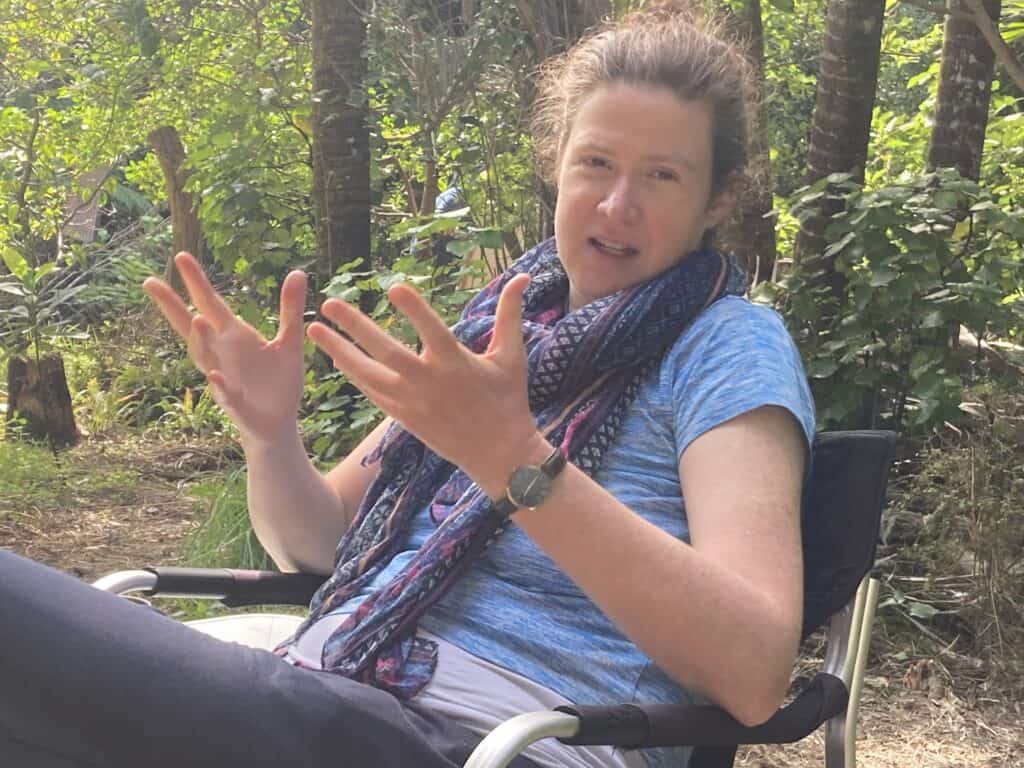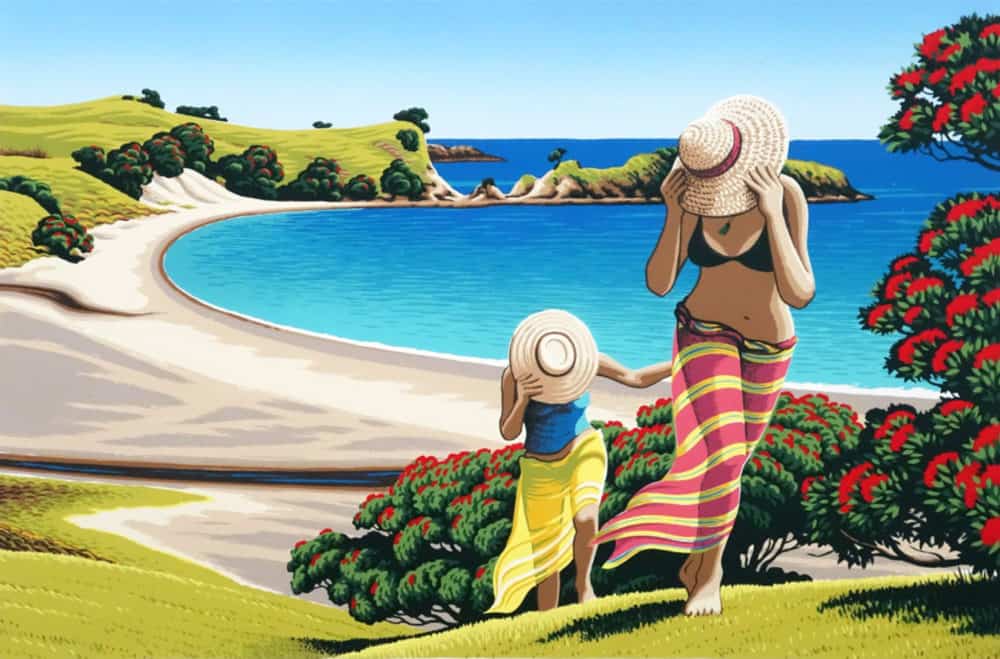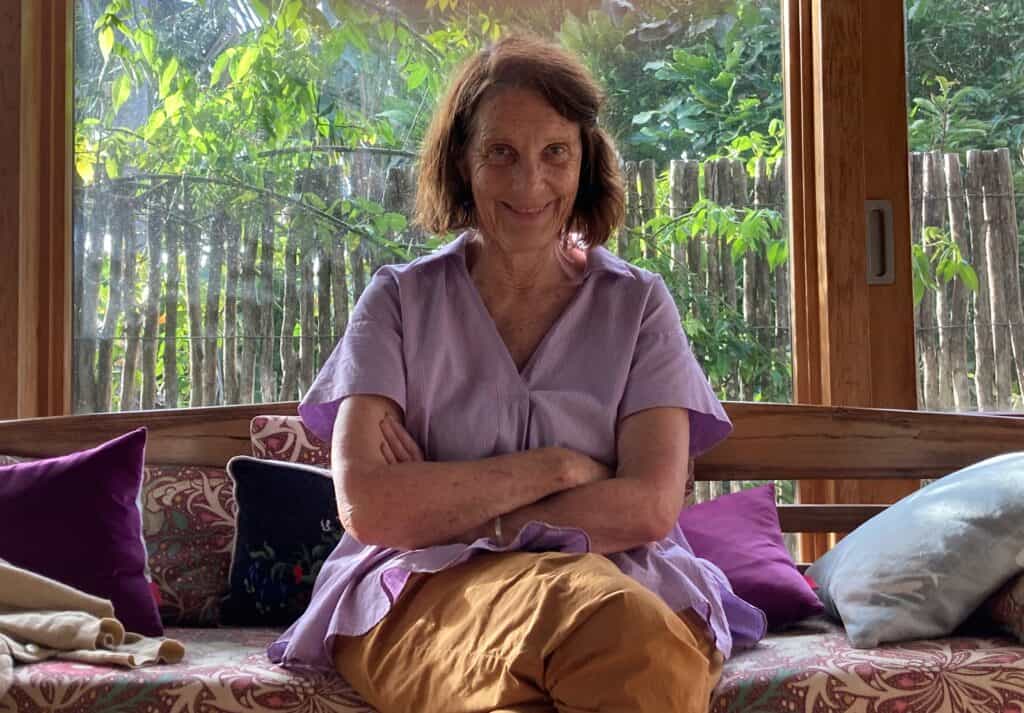Port Chalmers-based, Ireland-born writer Majella Cullinane spent nine weeks in a one-room log cabin on Aotea as part of a writing sabbatical funded through an Auckland Museum Research Grant.

The cabin belongs to her partner’s family, who acquired land on the island in the 1960s and have always wanted to retain its unique character. The logs – tanalised posts – were barged in and assembled in a grove of nīkau and pūriri well above the beach.
Its solar panels aren’t enough to power a laptop, just phones and torches, but Majella has always written her first drafts longhand anyway, including two poetry collections and the WWI-set novel The Life of De’Ath, longlisted for the 2019 Ockham New Zealand Book Awards. She’s currently revising her third poetry collection.
While Cyclone Dovi whipped around the cabin in February, she sat next to one of its small windows filling her notebook with island-inspired characters and plotlines.
The flailing trees seemed to reflect the distant world – the pandemic, the threat of war, spiralling inflation. And informed stories that became infused with the local – a scratch from mingimingi on the walk to take their 11-year-old son to Mulberry Grove School, a clifftop view of the Coromandel from a tangle of kikuyu grass, stingrays in the shallows during daily swims.
Majella – “a townie from Limerick” – says the moveable toilet stool, the mosquitos and the outdoor plumbing put her well outside her comfort zone.
But they also sparked a creative burst, with stories in progress about the SS Wairarapa disaster off Aotea’s north-west coast, the resident botanical painter Fanny Osborne, a car of Al Capone’s (which resided on the island for a while), and a contemporary tale of island escapism “that may become an interlinked short story collection or a novel”.
Sally Souness, owner of the Parnell Gallery, has hosted artists at her holiday home at the north end of Ōruawharo Medlands Beach over the years, including the painters George Bologhy, Russell Jackson, Paul Woodruffe and Cynthia Taylor together.
The gallery would invite four artists to explore ‘special locations’ around the country over several days “to sketch, photograph and return at the end of each day for superb food, wine and discussion”.
The artists’ interaction, personal styles and different interpretations would then be combined at an exhibition at the gallery.

Sandy Callister lives part-time on Sandhills Road behind Ōruawharo Medlands Beach and is a quiet patron of the arts on Aotea.
She occasionally offers the soft light and art-filled house she shares with husband Martin Baker, a Presbyterian minister, to artists for a three-week residency.
The scheme is run through the Aotea Ora Community Trust, which she is a trustee of, and advertised by shoulder tapping or word of mouth.
Four artists have enjoyed the generosity of the couple to date: husband and wife London-based, Italian-born furniture designer Martino Gamper and New Zealand-born sculptor Francis Upritchard; Whanganui poet and short-story writer Airini Beautrais, winner of the Jann Medlicott Acorn Prize for Fiction for Bug Week at the 2021 Ockham New Zealand Book Awards; and Pasifika photographer and social activist Edith Amituanai.
The contract she arranges with each artist also provides ‘flights, a rental car and an Okiwi Passion food box’ and requires them to give back to the community, through running workshops or talks at the art gallery or with The Hub, a learning support centre for secondary school students.
Sandy has a background in advertising, including a stint as research director in Saatchi and Saatchi’s office in New York, and an interest in arts curation – she is on the board of the Adam Art Gallery, funded through a Victoria University endowment, and has published a book of WW1 photographs.
She has a Doctoral Degree in Humanities and is currently completing a Master in Laws looking at how to improve social outcomes for the most vulnerable.

Her artists-in-residence scheme – which can easily fit in shoulder periods or when owners are not using their holiday home (and conversely with the childcare and school holiday commitments of artists) – is starting to attract the interest of other bach owners.
There are other places in the world, such as Fogo Island in Newfoundland, Canada, that are renown as meeting places and inspiration for artists.
Her deep interest in art pre-dates buying a bach here 30 years ago. She was aware then that painter Tom Kreisler’s family bach was one end of the beach and avant-garde artist Jim Allen’s the other.
“I recognised that this place attracts creative people and thought about how we might actively engage with a new generation of artists and makers.” She’d like to host “more writers, musicians and creative dancers”.
“It sets up a different conversation about what the island can be.”
Written by Tim Higham, with the support of Destination Great Barrier Island.

